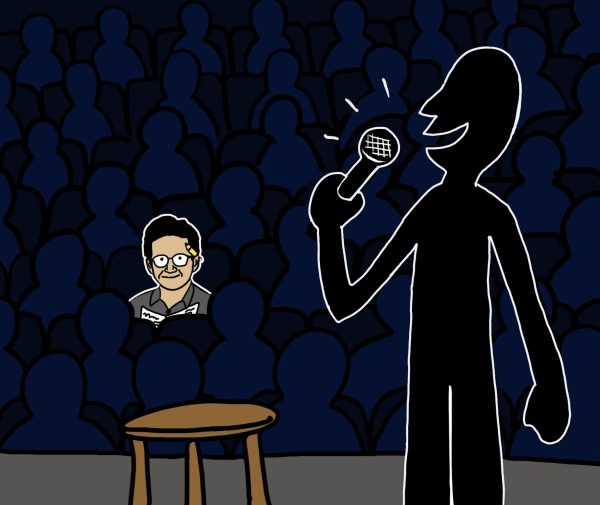A review of ‘Girl ‘Boss: looking at the glamorization of poverty
March 15, 2023
When I started watching the 2017 Netflix comedy Girlboss, I didn’t have high hopes. Based on the best-selling novel by Sofia Amoruso, it details the rise of Nasty Gal, a clothing brand built by the book’s author. While I couldn’t deny how interesting the story was of how the shop came to be and the irresistible charm of the quirky early 2000’s San Francisco setting, I saw an underlying issue.
The show starts with Armoruso losing what I assume was her sixth job in six months and finding an eviction notice on her apartment. She decides to steal a rug and sleep in the park. While homelessness is usually never a choice, the show glamorizes her spontaneity of choosing to sleep in the park. She then wakes up and goes out to eat with her (surprise) very wealthy father. She refuses to accept money from her evidently rich dad, because she wants to “make it on her own.” Sofia chooses to live in poverty, when many others have no other choice. She makes comments about how she can’t afford food, but can afford a vintage skater jacket, and never uses food stamps. She chooses to dance around poverty because it makes her feel “self made,” when her dad has supported her most of her life. Later in the show, she develops a uterine cyst, which could be lethal and is taking a toll on her health. Despite her constant pain and fear caused by this, she rolls her eyes when her friend suggests she goes to the free clinic and says “I would never.” Her attempt to distance herself from poverty, yet displaying herself as poor, is not an uncommon occurrence.
In the media, poverty is often glamourized. “The American Dream,” or the idea that you can pull yourself up by the bootstraps in any situation, is a common ideal. However, the reality is that in the U.S., upward mobility is incredibly difficult because poverty is cyclical—many times the poor stay poor as the rich get richer. Girlboss is a perfect example of the problem. It presents a false narrative of what poverty actually looks like. Shows like Sex and The City glorifies poorness by portraying its characters as broke when, in many cases, they are far from poor. We can thank the iconic Carrie Bradshaw for a quote to sum it all up: “When I first moved to New York and I was totally broke, sometimes I bought Vogue instead of dinner. I found it fed me more.” While this is obviously not literal, it shows how being poor is used as an accessory, or a lifestyle in media, rather than an inescapable reality. It’s especially common for it to be used by white women in the media. It’s almost an aesthetic for them to be poor, but only in a certain way. Having only thrifted or vintage clothes, only eating junk food and still staying a size two. It furthers the unrealistic standards for women to be physically perfect regardless of their situation. It’s hard to watch women displayed as poor with washboard abs, clear skin, and a perfect wardrobe with no outfit repeated regardless of supposed lack of funds. We can turn on our favorite sitcoms and see the main characters living off of junk food because it’s the only food they can afford, when they have a new pair of Steve Madden heels every episode. This completely ignores the reality of many impoverished people living in food deserts, or neighborhoods with no fresh food options. This causes a myriad of health issues such as heart failure, obesity, diabetes and gives them a shorter life span. This is what I would like to call ‘choice poverty.’ While real poverty is never a choice, these characters are shown as poor when it makes them more dynamic characters, and not when it comes to the not so pretty part of poverty. These shows use being poor as a character trait, rather than an actual condition they have to face.
Let’s look at more examples of this idea beyond Girlboss. In Gossip Girl we can see a misconstrued idea of what poverty is with one of the main characters, Dan Humphrey. He lives in a huge penthouse in Brooklyn, yet is seen as poor. While his wealth pales in comparison to his millionaire friends, he is in no way poor. We are taught to pity him and his family in the show, but they are far from struggling. They are living in a loft worth about a million dollars, which is definitely not my idea of poverty. Often shows portray what they think is poverty, but are actually just less wealthy. Poverty is used not only as a quirky personality trait but also to make us feel bad for certain characters. The “poor” characters have to work harder than anyone else on the show just to fit in with the luxurious culture. But the problem is they often are not poor, leaving the viewers to feel pity for normal upper middle class people. It makes us feel like we need to be uber wealthy to be successful, happy and content, because anything less than that is seen as pitiful.
Girlboss is an excellent example of this phenomenon. Sofia is shown as impoverished while she sits in her gorgeous loft in downtown San Francisco. Her room is surrounded by clothes she got from thrift stores for a fraction of the price that she is selling them for. These are stores made to clothe poor people, yet she takes the clothes, cuts them up and sells them for 200 people. While some may argue that re-selling vintage is sustainable compared to fast fashion, Nasty Gal is now one of the biggest fast fashion brands in the world. What started as a creative way to make a living has morphed into a company actively exploiting workers and contributing to climate change.. According to a survey conducted by Good On You, a fashion sustainability company, Nasty Gal is not doing so hot. Their labor conditions received their lowest ranking, because they don’t pay many of their employees a livable wage. They even fired a woman for being pregnant rather than giving her maternity leave. The company also received a low ranking for sustainability, as they use low quality materials that are not made to last. The company was purchased by Bohoo for 20 million in 2021, which is one of the biggest fast fashion brands in the world. While Sofia started a scrappy, do it yourself, hardworking business, now she is a multimillionaire who runs an exploitative brand. The key is that this never would have happened if she was actually as poor as the show makes her out to. She couldn’t have bought thousands of dollars worth of high quality vintage clothes and shipped them all over the country if she could barely afford food. The media must do a better job in considering what poverty really looks like; it’s not a quirky personality trait, but rather a dangerous and scary reality many people face every day.




















